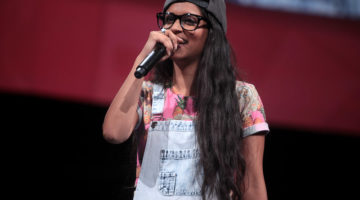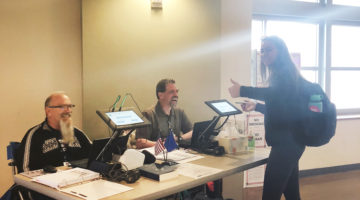
Andrew E. Weber/Pexels
A man stands in front of a television with static on the screen. Recent research shows television viewing habits may be able to predict election results.
This year has proven to be difficult for polling, from the unexpected rise of Donald Trump’s to an equally unforseen Brexit. But two college professors may have found a suprising alternative — voter television viewing habits.
University of Nevada, Reno, assistant professor of information systems Arash Barfar and his research partner, Balaji Padmanabhan, a professor of information systems and decision sciences at the University of South Florida, researched how to forecast U.S. presidential election outcomes based on the television viewing habits of voters in swing states.
To predict the outcomes of the 2012 presidential election, the two professors used television viewing data from Nielsen, a research company that tracks television viewing habits of large samples of U.S. households. The data Barfar collected was from television shows individuals had watched four weeks ahead of Election Day, Nov. 5, 2012.
“In the big data world, the days of surprise about election outcomes are likely to be fewer in the years ahead,” Barfar said.
Along with the data Barfar and Padmanabhan collected from Nielsen, they used data on the minutes each voter spent watching a television program and the percentage of “fans” of different television programs to determine which programs were the most popular and would be the best to analyze.
Barfar and Padmanabhan used television data from states where election results were predictable to create research models in order to predict 2012 outcomes in the battleground states of Florida, Ohio, Iowa and Nevada.
“This approach allowed us to generalize different units of analysis,” Barfar said. “We used them to build predictive models that could potentially be used in real time.”
The research pointed Barfar to two shows that had the highest prediction accuracies: “The Daily Show with Jon Stewart” and “Duck Dynasty.” According to Barfar, the two shows also supported two political opposites.
Building off their data and research from the 2012 presidential election, Barfar and Padmanabhan began to change their models to predict outcomes of the 2016 presidential primaries.
“Building on our 2012 election work, we recently received television viewing data from Nielsen for the months corresponding to the 2016 primaries,” Barfar said. “We have embarked on a similar analysis, keeping in mind that primaries are more complex to predict.”
According to Barfar, there were several more challenges in predicting primary election results than general election results because of a voter tendency to be swayed by the results of another state. Barfar also said Nielsen panelists may not have been representative of the voters in the primaries due to the voter restrictions that change state by state.
Even though the presidential primary proved to be a challenge, Barfar created over 31 Trump/Not-Trump models to predict the outcome of the primaries that resulted in over 80 percent accuracy.
In his Clinton/Sanders models, Barfar’s data from 29 television shows gave him over 73 percent accuracy in his predictions.
According to Barfar, two shows proved best to help predict the outcome. “Chrisley Knows Best,” an American reality television series, was a Trump supporter favorite and “Key and Peele,” an American sketch-comedy television series, was a Clinton supporter pick.
“In both cases, we saw victories for Trump and Clinton in states with higher viewership of these shows,” Barfar said. “We are continuing to examine the individual models and the various timelines to determine how robust these shows might be over the long term.”
Though television viewing data proved an accurate indicator of election results, the researchers say they will be unable to tell if the data is a useful predictor of election outcomes until they are able to test their predictions in real time, ahead of an election outcome.












